Correct Draw Length. How To Get Proper Draw Length. (With Pictures.)
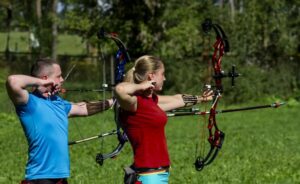
What is one of the most important aspects for archery and bowhunting? The answer is accuracy, without it you are shooting at the whole barn door. For target archery, field, 3D archery and bowhunting, accuracy is king. Without it, you are going home without the trophy, literally.
So how do we get more accuracy? Well it is not by having the latest high tech bow or archery equipment. It is from quality practice and having correct form. A very large part of good form is the draw length.
A shoulder width stance, with a straight “T” form and anchoring the bowstring around the corner of the mouth, will give better arrow groups. Combine a solid consistent anchor point and your accuracy will be better.
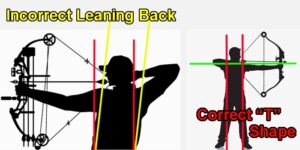
Above image: The image to the left shows incorrect form with a too long of a draw length. This causes the archer to lean back too far. The photo on the right shows a correct stance.
The proper draw length for consistency.
The precise draw length is one of the big keys to accuracy, in fact the correct draw length will set you up for holding on the target better, a better release, even your stance will be more comfortable and you can hold on target longer. If you combine the correct bow poundage with quality practice and the ideal draw length, you are going to be a better shot.
Another way to put how important a proper draw length is with an analogy – “The correct draw length is like getting the correct shoe size for your foot. While you might be able to struggle forcing a smaller shoe on your foot, or wearing a bigger one, it will not be comfortable. You will also never compete with other top runners without the correct shoe size.”
When I was instructing archery, I would say 70 to 90% of compound archers had too long of a draw length. (This goes for field archery, bowhunting and target set-ups.)
Interestingly enough, I would say for recurve and longbow archers it was the other way around.
A lot of the recurve and longbow archers had a draw length that was too short. With longbow and recurve shooters, a lot of them were over-bowed, (Too much bow poundage. I know, I used to do it.) The result was, the archer would short-draw the bow and not expand into the correct full draw length.
With a recurve bow or longbow it is important that you do not have too heavy a draw weight. As this will reduce your draw length as you won’t be able to pull the bow correctly back for your ideal draw length.
Why do most compound archers have too long of a draw length?
Most are unaware that they have too long a draw length set up on their compound bow for a start.
The compound bow has a specific draw length. It will not draw any further so it is important to match up the bows draw length measurement with the archers draw length.
The archer may not realize what the right draw length feels like, looks like and the benefits of proper form. Click on How To Figure Out Your Draw Length to get you in the ballpark for the draw length.
Also visit, How To Measure A Bows Draw Length on information on a bows draw length.
The archer also may not know how to change the draw length settings on the bow.
Years ago, to change the draw length on a compound bow you had to use a bow press to do it. Today, thankfully a lot of bows don’t’ need a bow press to change the length. However, I still see very vague, unclear and confusing instructions from the manufactures on how to change the draw length or modules, etc., on most bows.
(How hard would it be for the compound bow manufacturer to put out a YouTube video on how to change the draw length on a XYZ type of bow? And some clear paper, or website instructions on how to do it. Hint, hint.)
Another reason is most compound bows are set for 29” at the factory. (I am not sure why this is, as this length is better suited for a medium / tall person. The average male archer might use around a 28 inch draw length.) I assume it is set that way, because people love speed. A bow that draws longer at 29 inches, will have more power stroke and better arrow speed, then a bow at 27 inches. Putting an arrow through a chronograph looks better with a longer draw length.
Even some bowhunting and archery pro-shop owners have too long of a set up length. So the shop owner might mistakenly set up the bow for the customer without knowing any better.
A few minor reasons why the draw length is too long, is the strings and cables can stretch on the cheaper compound bows.
Another reason is a correct length d-loop is hard to tie when it is short. It is easier to put a longer d-loop on the bowstring. (A d-loop doesn’t technically change the bows draw length, but changes the archer’s position when anchoring at full draw.)
Why is too long of a draw length, a negative for accuracy?
There are several reasons why a draw length that is too long won’t give you the best accuracy. Let’s look at some points: Inconsistent anchor point, bowstring slap, balance and uncomfortable stance, bad face and eye alignment, to name a few.
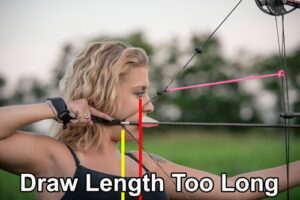 Above photo: The compound bow’s draw length is too long for this female archer. The draw length needs to be shortened by about an inch to 1 1/2 inches or more. This will put the bowstring and peep sight in line with the eye and less bowstring contact on the face. The red line indicates where the bowstring should be at fulldraw – at the corner of the mouth.
Above photo: The compound bow’s draw length is too long for this female archer. The draw length needs to be shortened by about an inch to 1 1/2 inches or more. This will put the bowstring and peep sight in line with the eye and less bowstring contact on the face. The red line indicates where the bowstring should be at fulldraw – at the corner of the mouth.
When the draw length is too long, the bowstring is not in line with the eye. Because of the angled shape of the face, the bowstring is more off to the side. The archer then tries to look through the peep site, putting even more pressure on their face, causing more string contact, or torquing the bow to try and see their peep sight. Their head position can also get in an unnatural position, causing the stance and balance to be off.
Also the angle of the eye can make the vision less clear.
Another reason that can affect accuracy is that the archer may not to be able to consistently anchor on a hard bone part of the face, jaw bone or neck. For compound archers this will depend on the type of release aid device used, such as a wrist strap model or a handheld thumb “T” type release. However, too long of an anchor point and there is nothing solid to draw to and feel.
If the anchor point is floating, it won’t feel comfortable and you will be inconsistent with your shots.
When you get tired, excited or stressed on the target range, or when bowhunting, the unnatural form will go out the window and you will magnify the inaccurate shooting.
A stable stance is very important in archery. If you are leaning back because your draw length is too long (Not shooting uphill or at a long distance.) this can unbalance you. Combine strong wind with leaning back and your arrow groups are going to be even worse.
Your torso position should be built on good foundations of the legs and glutes in a nice solid “T” shape.
For beginner archer, it can feel awkward to fight the bowstring, hold at full draw and aim at the same time. But with plenty of quality practice, our learned behavior becomes ingrained and easier. However, you should be reasonable comfortable on the physical side, so you can concentrate on the draw cycle and aiming. With a too short or too long bow set-up, you won’t feel comfortable.
Now we know how crucial our draw length is, let’s look at some common mistakes that archers make and how we can correct them.
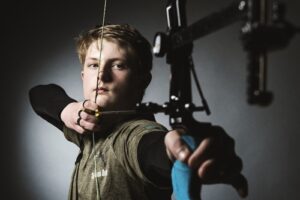 Above photo: The recurve archer has proper eye / string alignment. The compound archers below have a good stance and form.
Above photo: The recurve archer has proper eye / string alignment. The compound archers below have a good stance and form.
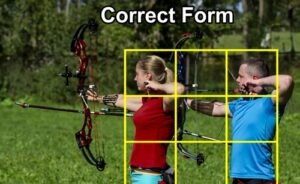
Common signs of a draw length that is too long.
Here are some indicators that you have an incorrect draw length. Now some of these signs can be from other causes, like no practice or target panic. But here are some things to be aware of.
Leaning back. (The target is close by and around torso level. The archer is on level ground, but they are leaning back.)
Flinching and the bow nearly takes off.
String slap on the forearm most of the time.
Your bow arm elbow is hyperextended.
The bowstring and / or anchor point is not near the corner lip, but back on the face.
The bowstring or peep sight is not in alignment with the eye.
You are of a medium to short height and you are using a 29” draw length on a compound bow.
The bow-arm floats around and it is hard to center the target sight pin on the target.
You may get a lot of high and low shots on the target.
The equipment is well tuned, you practice a lot, but you keep getting inconsistent scores or groups.
Your elbow is way lower than the line of the arrow when at full draw.
From an overhead view, (Eagle eye view) your upper arm and elbow aren’t in a good line. Your bow string elbow is too far behind your bow arm and body alignment.
The exceptions of an textbook draw length.
There are some exceptions of the above warning signs, which are not related to having an incorrect draw length. Some common and uncommon ones could be:
The archer might have hip or back pain, shoulder, elbow joints injury or a mobility issue. They can’t stand normally or use form that allows a good “T” structure.
Generally a medium height male person will have around a 28” draw length. A shorter archer might be 27”, 26”, 25” and under, depending on height and if they are male and female. A tall person might have a 29” draw length and over. For a very tall archery they might have a 31” or 32” draw length. However, humans can range widely in physical structure and have a combination of different arm lengths and torso lengths. Also the shoulders can be very narrow or wide, so their draw length will differ for each person, even if the archer is the same height as another. That is why I am hesitant to say if you are five foot ten, you should have a certain length draw length.
Some archers might just prefer an uncommon stance or anchor point. Perhaps they get good consistent arrow groups and scores regardless of what their form looks like. (It is hard to argue with that.)
Some archery aiming methods for whatever reason might make the archer appear awkward. As an example anchoring in front of the chin for Olympic style target archery might be difficult for some archers, compared to a low side chin anchor.
If you are shooting a target a long way away for Olympic archery distances then you are going to appear to be leaning back.
How To Get The Proper Draw Length.
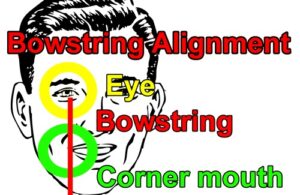
Ideally the bowstring will be at the corner of the mouth. This helps align the peep sight for compound archers. Also there is less face interference on the bowstring. For recurve archers the bowstring can be aligned with a bow sight. Or it can help a barebow aiming method be more consistent as the bowstring/ arrow is more aligned with the eye.
You stance will be strong, with your feet, hips and shoulders in alignment. Not leaning backwards or forwards. Too close of a stance and the wind will topple you.
For windy days or on uneven ground you might have your feet spread apart a little bit more, but basically around shoulder width for your stance.
Another good way is to tell if your draw length is incorrect is by an experienced archer. Check out your local archery club. Some top target archers are very fanatical about a precise draw length, so they should be able to help.
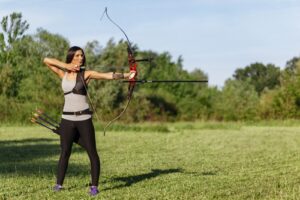
The female recurve archer above has good form as her stance is nice and straight.
How do I know if my draw length is too long?
So you can see what your form looks like and where your draw length is, take some photos.
Take photographs of your stance at full draw from side on. Also a close up on your face of your anchor point at full draw. Try to see where the bowstring is located on your face. Also the position of your bowstring arm and elbow position.
If you can’t get someone to take the photos, place the camera on a tripod with a timer, or video tape yourself.
Make sure you are on level ground for your stance. As well, have a large target placed around shoulder height, so you are not aiming down at the ground. Likewise don’t have the target too far away, otherwise you will be aiming up.
The unscientific experiment.
If you are not sure what your draw length should be, try this experiment for a few practices. Give it a few goes and record your score or group size in similar weather and conditions to what you normally shoot. (Obviously don’t try this on the day of a big competition.)
For a compound bow shooters, shorten the bows draw length by an inch. At the very least it might be ½ an inch. If you weren’t set up by a qualified archer, for most beginner archers it could even be adjusted 1 ½” shorter.
For beginner longbow and recurve archers, try dropping the bow weight by 5 lbs. to 10 lbs. (It might be more if it is a hunting bow weight. It might be less for a target recurve bow.) Regardless if you use bow sights or a barebow aiming method, try standing more erect and expand the draw length at full draw. The draw length might be increased by an inch or more.
Even though you will drop arrow speed by the lighter draw weight, you will pick up some arrow speed with the longer draw length and will have better control and hence accuracy.
Having mentioned about adjusting your draw length for the experiment, the best draw length is not shorter or longer, but just right for your body and shooting style.
Conclusion – Correct draw length.
You see it all the time at the range, archers leaning back, the bowstring is drawn half way between their mouth and ear, the bow arm floating widely about all the time. The result is poor scores, but the equipment, range set-up and wind gets blamed. So the proper draw length is vital.
The ideal length draw will help you with two main factors of being comfortable and consistent. This helps accuracy and again comes down to the correct draw length.
